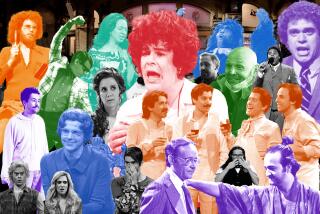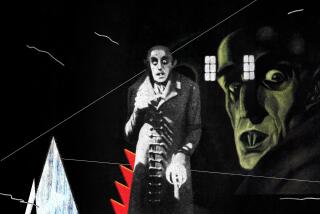Setting the Tone : Jonathan Wolff has been creating music for TV since 1982. His biggest, latest hit is the theme for âSeinfeld.â
BURBANK â A few years ago, composer Jonathan Wolff received a phone call from Jerry Seinfeld, who had been referred to him by a mutual friend, comedian George Wallace. Seinfeld needed a theme song for his new television series, then called âThe Seinfeld Chronicles.â Other composersâ efforts had not met his criteria: something catchy that would underscore but not interfere with the stand-up routines he planned to do at the beginning of each episode, and that also could be used between scenes during the show.
Wolff thought, âWhere others have tried and failed, how can I avoid the land mines?â He watched videotapes of Seinfeld doing stand-up--and thus was born the series of finger snaps, lip pops and tongue clucks that make up the quirky theme song heard each Thursday night on the NBC series âSeinfeld.â
âWatching the tapes, I diagnosed (creating a theme) as a sound-design problem, not a soundtrack problem,â Wolff, 36, recalls, sitting in the lounge area of his Burbank Boulevard office/studio, Music Consultants Group Inc. âThe melody is Jerryâs voice. So instead of using drums or other instruments, I used sounds that could go with his human voice and used the pacing of his words to go with his tempo. I did use a bass, which has a frequency range that does not interfere with the voice.
âJerry seems to talk at a pace of 110 beats a minute,â he adds. âI think of that like a brisk walk--a âgotta get to the curb, gotta catch my cabâ kind of energy. I wanted it to be kind of New York-sounding.â
Capturing the tone of a show--usually as envisioned by its producer--and setting up the viewer for what is to come is precisely what a theme song is supposed to do, Wolff says. âWhen you go to an opera, there is an overture, and the curtain rises. Itâs part of the experience, the feeling of being entertained. Thereâs a heightening--you rise to it.
âSometimes a theme song takes you to the place,â he adds. âWith the moose in âNorthern Exposure,â by the time itâs at the end, youâre there, ready to watch the show.â
Wolff may not have written that seriesâ theme song, but he is one of televisionâs most prolific composers. He had been scoring episodes of such TV series as âWhoâs the Boss?â since composing for âSquare Pegsâ in 1982; his first theme--or main title, in industry jargon--was for âThe Charmingsâ in 1987, with subsequent credits including Shelley Longâs sitcom âGood Advice,â âSaved by the Bell--The College Yearsâ and âThe Good Life.â
But it was the success of âSeinfeldâ that really put him on the TV music map. He now scores CBSâ âDaveâs Worldâ--for which he chose and arranged the Billy Joel song used as the main title--and Foxâs âMarried . . . With Children,â and created the theme and does the weekly music for âThe Boys are Back.â
*
His midseason shows include a CBS comedy about New York bicycle messengers, âDouble Rush,â from âMurphy Brownâ creator Diane English; âA Whole New Ballgame,â starring Corbin Bernsen on ABC, and âUnhappily Ever After,â a syndicated sitcom about a dysfunctional divorce. He was also recruited to revamp the venerable âMickey Mouse Clubâ song for The Disney Channelâs current crop of Mouseketeers, which begins airing early next year.
That sort of output would be virtually impossible without Wolffâs state-of-the-art computerized electronic equipment, an array of recording devices, sequencers, consoles and speakers housed in the Burbank building he bought in 1986. The high-tech machinery allows him, for instance, to receive a âSeinfeldâ episode videotape on a Wednesday evening and have it scored by Thursday morning.
âThe equipment enables me to manipulate things so much easier,â he says. âItâs like a word processor--when I do on-screen editing, I can grab and move things in seconds. It gives me artistic flexibility too. I can try hundreds of variations of an edit.â
He also can incorporate those distinctly non-musical sounds he pioneered on âSeinfeld.â For the theme for the upcoming âDouble Rush,â Wolff, who bicycles to work from his Burbank home, used the sound of his bikeâs grinding gears and his own breathing. He then added fast-moving street noises such as horns honking and people shouting.
For the theme of CBSâ multigenerational sitcom âThe Boys Are Back,â though, Wolff used a traditional acoustic guitar after creator-executive producer Matthew Carlson mentioned that he liked the instrument; the only other input the composer had was Carlsonâs stipulation that the music must appeal to all ages.
Says Carlson: âHe took it from there. I didnât know what I had in mind until Jonathan showed it to me. This theme is bright and engaging--when itâs right, the theme is a perfect blend of music and the show. Jonathan also does segues throughout the show, musically wry comments about the action that are always appropriate and exciting.â
The television audience probably does not notice all of his composition subtleties, Wolff knows. âThey donât always get that a costume is handmade or a desk is real oak, either,â he says. âBut these details make for a richer, more inviting experience.â
More to Read
The complete guide to home viewing
Get Screen Gab for everything about the TV shows and streaming movies everyoneâs talking about.
You may occasionally receive promotional content from the Los Angeles Times.






